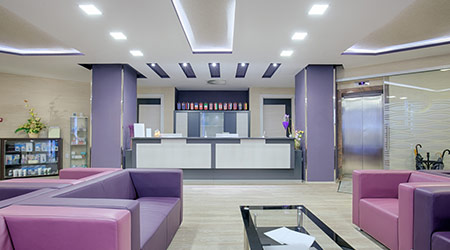There is a unique smell that accompanies newly purchased furniture and cabinetry. It’s distinct, like a new car smell. However, it’s also hazardous and fueled by the chemicals in PVC and laminates. Polyvinyl chloride (PVC) has become a conventional material in the healthcare industry. While the material has perks, like its easily cleanable surface, it does not come without controversy. One major pain point is the effect these chemicals have on indoor air quality and the lack of easy disposal.
Those sharp and hazardous aromas that accompany new furnishings are the result of PVC, urea-formaldehyde and VOC glues and their chemical compositions. What makes their use even more hard to justify is the fact that there is no known safe way to produce or dispose of PVC products. When the material is broken down, hydrogen chloride gas and dioxin are released, both of which are hazardous chemicals.
Being aware of non-PVC options should be a priority for planners and purchasers as they design and gather equipment and supplies for projects. To build a sustainable and eco-friendly institution, you must start with a solid foundation, and create an environment that will allow visitors to feel comfortable. The good news is that there are material options that mimic the look and feel of finer furnishings while being sustainable and avoiding the adverse side effects to indoor air quality.
In addition to PVC free upholstery, manufacturers have also shifted to LEED and CARB I/ CARB II compliant plywood. This type of plywood is constructed with no added urea-formaldehyde and utilizes water-based or UV-cured topcoats all while being assembled with low VOC glues.
This sustainability extends beyond chairs and beds. Manufacturers are producing environmentally safer alternatives for treatment tables, carts, cabinetry and more. Many products now meet or exceed the standards established by the California Air Resource Board.
Leading manufacturers are now mimicking the look and feel of leather upholstery, but without the trouble leather produces when it comes time to sterilize and prepare for the next patient. Using PVC-free materials, the seamless applications make it easy to disinfect these products, all while offering a product line that looks comfortable and welcoming.
Purchasing an air purification system is also essential in improving and maintaining indoor air quality. More importantly, these systems act as an active approach to preventing healthcare-associated infections and air contamination. Correctly installed active air purification systems have been shown to reduce airborne bacteria by 80 percent, as well as reduce surface bacteria by 66 percent. In addition to fighting HAI-causing bacteria, these systems have been reported to lower staff absenteeism, relieve allergy and asthma symptoms, and lessen healthcare odors.
Air quality matters to everyone, and supply chain executives have an opportunity to slow the depletion of ozone levels on a global level. While new regulations will go into effect closer to 2020, The Environmental Protection Agency has re-evaluated the impacts caused by refrigeration products and has adjusted its standards. The initiative revolves around phasing out traditional freon systems and replacing them with the greener hydrocarbon refrigerants like R290 and R600. These hydrocarbon (HC) refrigerants are natural, non-toxic refrigerants that have no ozone depleting properties and low Global Warming Potential (GWP).
Everyone benefits from fresh indoor and outdoor air and supply chain executives have the power to help keep it clean.
Cindy Juhas is the Chief Strategy Officer of CME Corp. Learn more at cmecorp.com.

 Building Sustainable Healthcare for an Aging Population
Building Sustainable Healthcare for an Aging Population Froedtert ThedaCare Announces Opening of ThedaCare Medical Center-Oshkosh
Froedtert ThedaCare Announces Opening of ThedaCare Medical Center-Oshkosh Touchmark Acquires The Hacienda at Georgetown Senior Living Facility
Touchmark Acquires The Hacienda at Georgetown Senior Living Facility Contaminants Under Foot: A Closer Look at Patient Room Floors
Contaminants Under Foot: A Closer Look at Patient Room Floors Power Outages Largely Driven by Extreme Weather Events
Power Outages Largely Driven by Extreme Weather Events